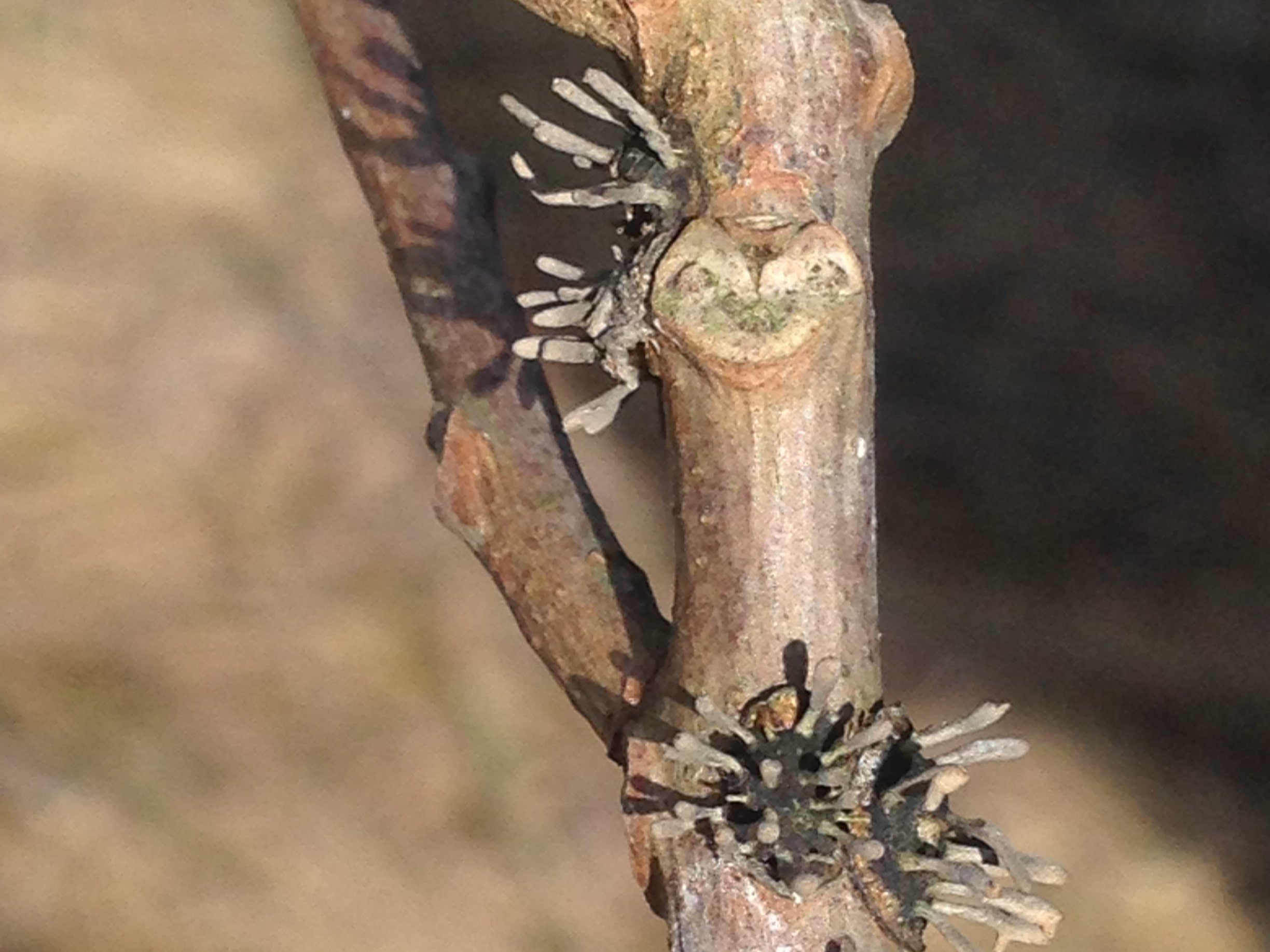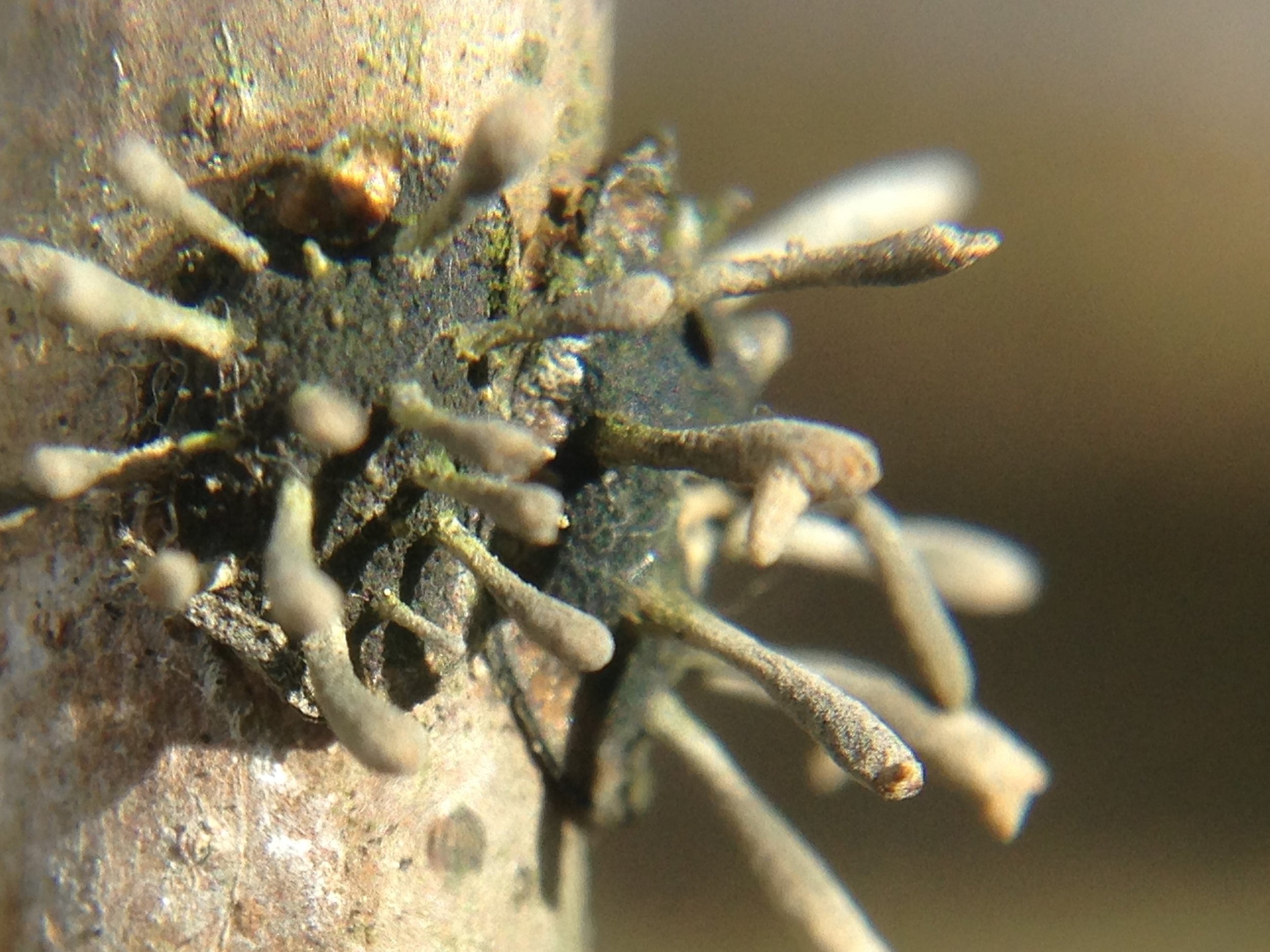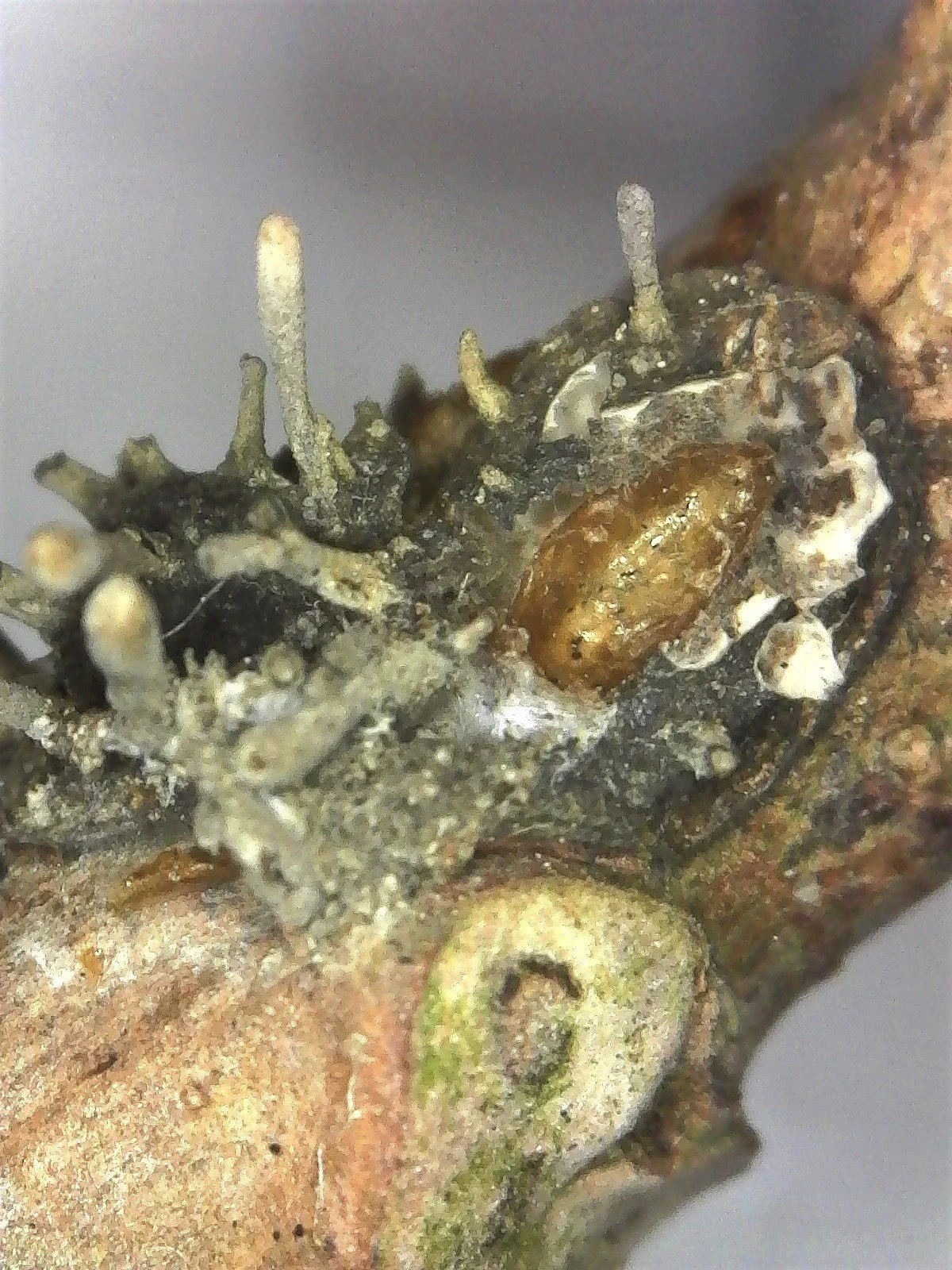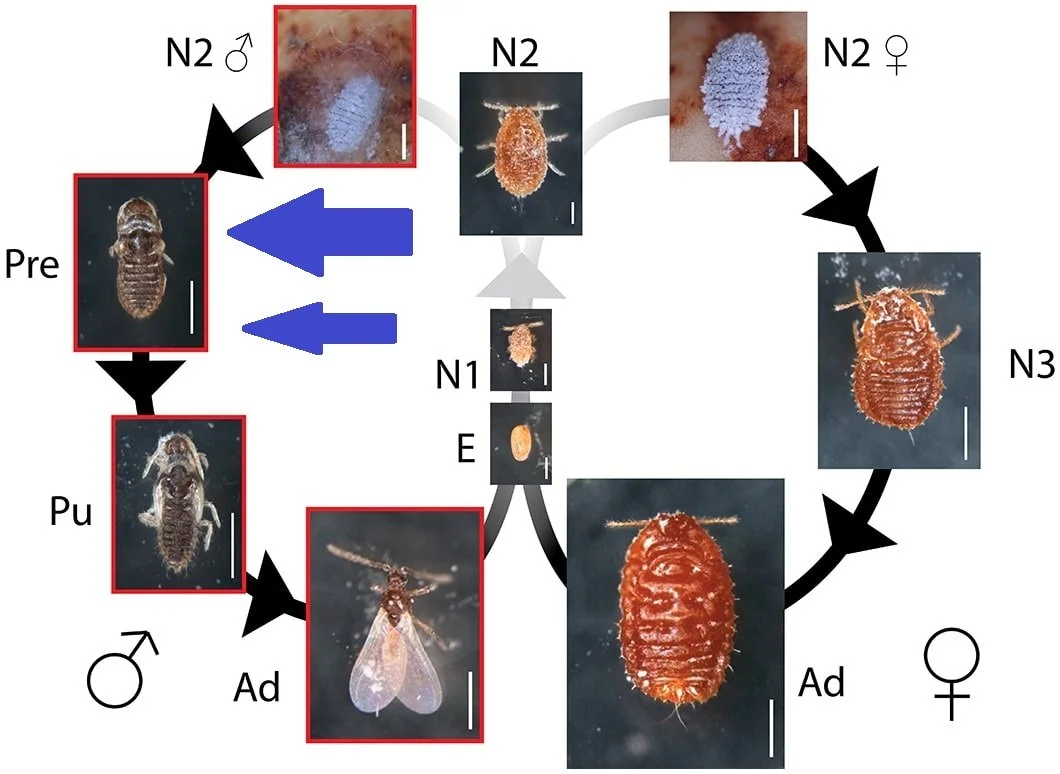Fungi on Black Walnut
I was out with the Learn The Land (LTL) class at Arkell Springs the other day where we were looking at some trees and shrubs in their winter attire, when we came across a Black Walnut (Juglans nigra) with a strange looking growth coming out of one of the twigs. We wondered about it for a while and then moved on. My partner and I ended up going back the following day to investigate some more.
Strange growth on Black Walnut (Juglans nigra) at Arkell Springs, 2023.02.20
Chambered pith of the Black Walnut (Juglans nigra)
We can tell it is a Black Walnut because of the leaf scar or bundle scar which is sometimes described as appearing like a monkey face. The leaf scar is where the leaf was attached to the twig. The spots within the leaf scar are where the veins which supplied nutrients and water to the leaf were once connected to the twig. Through examining the shape and size of the leaf scar we can tell different species of deciduous trees apart. We can also tell because of the place where the tree was growing, in a lowland meadow regenerating with mixed trees, without much shade. There was shade though, on the South side of the tree, where the branch with the visible signs of abnormal growths was located. Could they be connected? I could also tell because we broke the branch off and noted the chambered pith, telltale of Juglans species.
But the growth, I didn’t know. With the LTL crew I heard some guesses of a lichen, but the apothecia (fruiting structures) didn’t look lichen-ish to me. It looked more like a Dead Man’s Fingers fungus (Xylaria polymorpha) to me, so my mind first when to some infecting fungi. But, I feel like Walnut should be resistant to fungi for some reason. I don’t know if this feeling had a basis in fact, but it was certainly bouncing around in my mind while I was scanning the growths for clues.
Using the terminology of the Dead Man’s Fingers as this was what it reminded me of, the clavate (club-like) fingerish stromata (long structures protruding structures, stroma being the singular) were about 3mm long, and about .8-.9 mm thick at the head. They all emerged from a matte black base edged in green (algae?), and I counted 14 emerging from one base alone.
I ended up bringing the broken twig home so I could look further, and take measurements. When the twig was placed under my usb microscope I noticed a shiny brown scab like form on one of the bases, but I don’t know what it is.
So, what I assumed so far was that this was a fungus, it might be related to Dead Man’s Fingers, and it was growing on a Black Walnut. This seemed like enough to begin sleuthing on the internet, and asking questions on message boards. This is my standard protocol when I can’t figure something out. This and sharing photos on inaturalist in hopes that the AI might be able to help (it didn’t). But someone else had luck with inaturalist and I am grateful. Reddit user and master gardener /u/spiceydog took the photos I had uploaded and began searching as well. On inaturalistUK they found a pretty convincing match. It was Ophiocordyceps clavulata, otherwise known as “Bug Sputnik”. Ophiocordyceps clavulata specializes in infecting scale insects (more on that below), but the Cordyceps group of fungi infest all sorts of insects. The Cordyceps are probably most known for infesting ants, taking over their motor functions and making them climb high up into forbs and shrubs. When the Ant is high enough, they will solidly bite into the plant and dangle there by their mandibles. When the Ant is eventually consumed by the fungus, and if the temperature and humidity are just right, the fungus will eject it’s spores, which catch the wind, and will be dispersed more broadly only to fall on and infect new individual Ants continuing it’s fungal lifecycle. Cordyceps are often called “zombie fungus” in pop cultural nomenclature and there is even a television show, “The Last of Us”, which features a Cordyceps fungi which has evolved to attack and zombify humans.
But all of this was confusing. How does a fungi that is supposed to infest insects end up infesting a tree as well? I decided to take another look.
When I took another look I decided to poke apart the bases and see if there was sign of insect bodies or anything to show that this was infact an Ophiocordyceps species which had infected someone. It turns out that the brown shiny thing I noticed earlier wasn’t a scab afterall, but some sort of cocoon! This is where it may start to make sense for me… Or maybe not. Let me break it down.
Ophiocordyceps clavulata is supposed to infect scale insects, which are herbivorous insects with intense sexual dimorphism - the females have no limbs or wings, and look like tiny flat round bumps on a twig. The males, if there are males in a given species, may have limbs and wings, and look similar to flies. I am still learning about these insects and am still quite confused, as I bet most of you are, too. They may infest plants, sucking out the plants nutritious juices and leaving wounds behind for different fungal or bacterial infections. One such infection is found on Beech trees (Fagus grandifolia) and is caused by the Woolly Beech Scale (Cryptococcus fagisuga) and a couple of native fungi called Neonectria faginata and Neonectria ditissima. There is one scale insect I have learned about which infest Juglans species and they are called Quadraspidiotus juglansregiae or Walnut Scale. The Walnut Scale females are small, round, yellowy orange in colour, and kind of squishy or wet looking. When looking at whatever is on the twig, I don’t see Walnut Scale but perhaps this is because the Bug Sputnik (the fungi) is old?
The Walnut Scale life cycle, as described by Emily Symmes in a video on Managing Walnut Scale, really doesn’t really get active until Spring. That could mean that last Spring the Walnut Scale was alive. Then maybe the Bug Sputnik comes in and starts to infest the scale insects. Amidst the transformation of one male Scale, in their prepupal form, the fungi grows over top of them, perhaps even within them, and the male escapes or dies and the prepupa “shell” remained. That could be the shiny brown shape, which I discovered was hollow and tubular in the video above, taken with my USB microscope.
Scale insect lifecycle from the paper Differential Juvenile Hormone Variations in Scale Insect Extreme Sexual Dimorphism. Note blue arrows pointing to the male prepupa image.
The theory above is my running theory, but really I don’t know. I have a lot to learn about Scale insects, Cordyceps and how they interact on Black Walnut. I also recognize that the field of research around these things is also small, and that sometimes our very observations can teach not only us, but also inform researchers. So many cool things are out there, things like galls, mosses, entomophagous fungi, and even the Black Walnuts, we don’t know about as a culture. For now though we can observe, and take joy in the beauty and struggles of the world around us.
To learn more :
Ophiocordyceps clavulata entry from MycoQuebec
Ophiocordyceps clavulata entry on UKinaturalist
Walnut Scale info page from the Entymology department at University of Kentucky
Emily Symmes in a video on Managing Walnut Scale
Differential Juvenile Hormone Variations in Scale Insect Extreme Sexual Dimorphism





